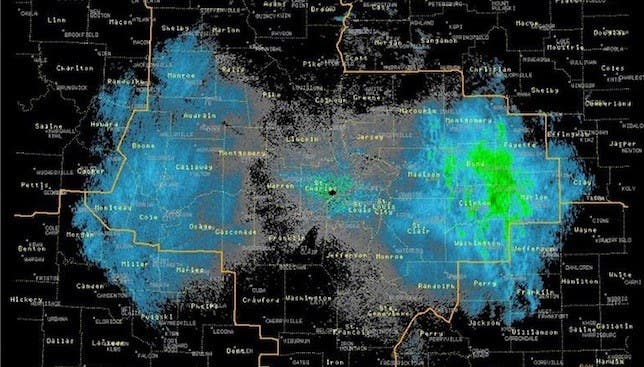
The US Weather Service captured this strange anomaly, which was in fact the monarch butterfly “cloud”. Image: U.S. National Weather Service.
Radars picked up a “strange cloud” with a bizarre shape above the US Midwest. Upon a closer look, it was revealed that the cloud was actually monarch butterflies traveling from Canada to Mexico – an iconic migration which has been less and less visible in recent years, but may make a resurgence in 2014.
Monarch butterflies are the most iconic butterfly species in North America. Every year, they migrate from the US and southern Canada to Mexico, in one of the most spectacular displays in the natural world. Apparently, it’s not spectacular only from the ground, but also on radars.
Radar maps from St. Louis, Missouri, showed something unusual last week: a large, slow-moving cloud that was changing shapes as it drifted south. For a meteorological formation, it look very bizarre, and to make things even stranger, it seemed to constantly change its shape. For a while, radar operators were baffled; what could it be? After a while, they realized that it wasn’t in fact a cloud, but it was actually monarch butterflies, migration towards Mexico by the millions.
“Keen observers of our radar data probably noticed some fairly high returns moving south over southern Illinois and central Missouri,” the National Weather Service says. “We think these targets are Monarch butterflies. A Monarch in flight would look oblate to the radar, and flapping wings would account for the changing shape!”
Indeed, further reflectivity analysis confirmed that the cloud had a biological nature – and this is much welcomed news! Biologists have reported year after year a significant decrease in their numbers and in August this year, the Center for Biological Diversity and the Center for Food Safety filed a legal petition requesting Endangered Species Act protection for the monarch and its habitat. A definitive response has not been issued.
Still, while it’s too early to draw any positive conclusions, there are indeed some good signs. Experts in Mexico explain that the butterflies have started their migration earlier than usual this year, but it’s still not clear if this means their numbers are starting to rebound.
Their migratory adventure will span over three countries, over 2,500 miles, and on average, lasts 4 butterfly generations. We’d like to wish them good luck, and hope their numbers continue to grow!










